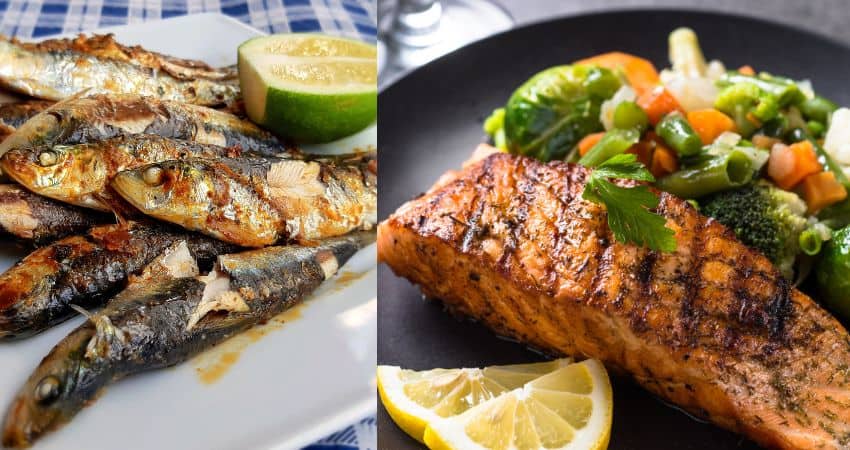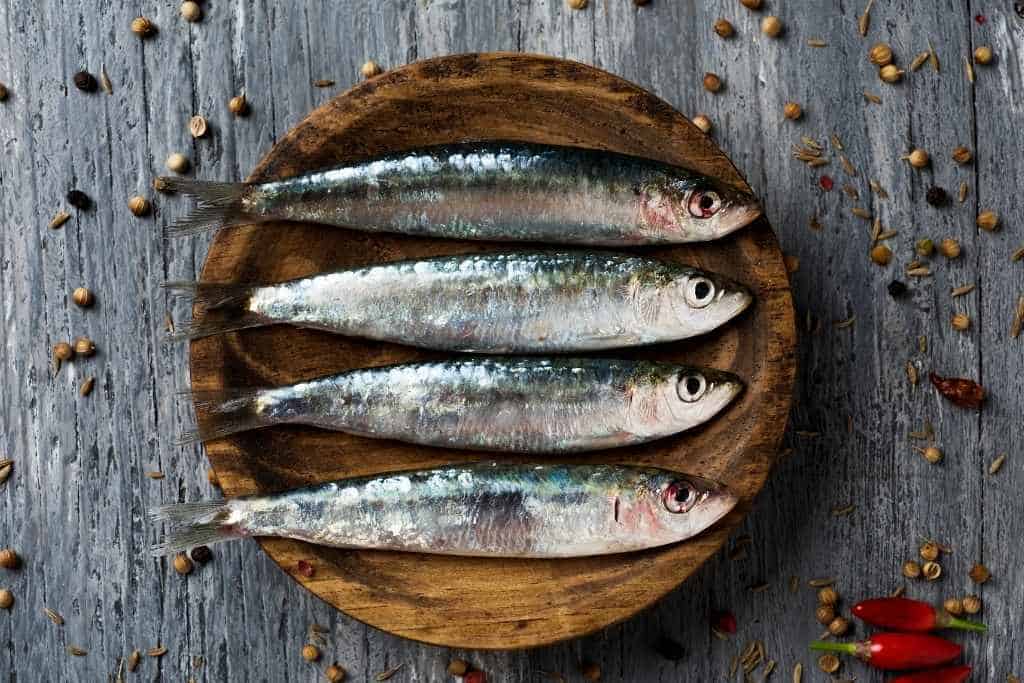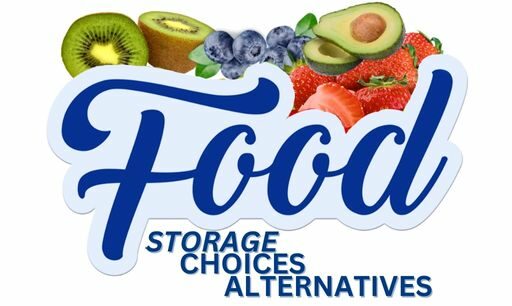Sardines vs Salmon: A Complete Comparison
Of the thousands of different types of fish out there, salmon and sardines are two very popular varieties. Although widely sought after sardines and salmon have many differences.
Salmon are fresh and saltwater fish while sardines are saltwater. Salmon are larger and weigh more than sardines. The average salmon is 28-30 inches long while sardines range from 6-12 inches. Salmon contains less calories, total fat and sodium than sardines. Canned salmon costs a little more than canned sardines.
This article will examine their differences in complete detail. Included is a side-by-side comparison of all their nutrients. In addition, I’ll compare their benefits, tastes, textures, mercury levels and costs.
Sardines and Salmon Nutrient Comparison

As a Certified Health Coach many clients ask me about food comparisons including sardines and salmon. I purchase and consume salmon every week. Therefore, I have researched this topic in the past and present. Let’s examine them closely.
For the nutrient comparison, the table below compares 4 ounces of raw salmon to 4 ounces of sardines. The sardines are canned, packed in water, boneless and skinless.
Sardines are extremely perishable, which is why it’s difficult to find them fresh. Almost everywhere, you’ll find them canned which is why I compare the canned sardines first. Down further, I compare canned sardines to canned salmon.
| Nutrient | Sardines, raw Canned(4 Ounces) | Salmon, rawFresh(4 Ounces) |
| Calories | 210 | 161 |
| Fat | 12 g | 7.2 g |
| Saturated Fat | 3.0 g | 1.1 g |
| Cholesterol | 69 mg | 62 mg |
| Protein | 24 g | 23 g |
| Sodium | 469 mg | 50 mg |
| Omega-3 | 1.65 g | 1.95 g |
| B-6 | 0.1 mg | 0.9 mg |
| B-12 | 10.2 mcg | 3.6 mcg |
| Thiamin | 0.05 mg | 0.20 mg |
| Riboflavin | 0.26 mg | 0.40 mg |
| B5 | 0.6 mg | 1.8 mg |
| Iron | 2.6 mg | 0.9 mg |
| Niacin | 4.7 mg | 8.9 mg |
| Folate | 27.2 mcg | 28.3 mcg |
| Potassium | 386 mg | 555 mg |
| Magnesium | 38 mg | 32 mg |
| Phosphorus | 415 mg | 226 mg |
| Calcium | 272.1 mg | 13.6 mg |
| Zinc | 1.5 mg | 0.7 mg |
| Selenium | 46.0 mcg | 41.4 mcg |
Nutrition Sources ((Nutrition Value: Fish, raw, wild, Atlantic, salmon))1
Both fish have a good amount of various vitamins and minerals. They both have a high percentage of omega-3 fatty acids. Let’s examine which one has more nutrients.
Fresh salmon is healthier than canned sardines due to its higher number of omega-3 fatty acids. Fresh salmon contains less calories, total fat, saturated fat, cholesterol and sodium than canned sardines. In addition, fresh salmon provides more B6, thiamin, riboflavin, B5, niacin, folate and potassium.
Sardines contain more vitamin D, iron, magnesium, phosphorus, calcium, zinc and selenium. Although less than salmon, sardines contains a good number of omega-3 making it a healthy fish to consume.
Canned Salmon vs Canned Sardines: Nutrition Values
For those who are interested in canned salmon vs canned sardines, I put together a table of their nutrients. I included red and pink salmon.
| Nutrient | Sardines, raw Canned(4 Ounces) | Red Salmon, rawCanned(4 Ounces) | Pink Salmon, rawCanned(4 Ounces) |
| Calories | 210 | 189 | 156 |
| Fat | 12 g | 8.4 g | 5.7 g |
| Saturated Fat | 3.0 g | 1.6 g | 1.0 g |
| Cholesterol | 69 mg | 90 mg | 94 mg |
| Protein | 24 g | 27 g | 26 g |
| Sodium | 469 mg | 463 mg | 432 mg |
| Omega-3 | 1.65 g | 1.67 g | 1.38 g |
| B-6 | 0.1 mg | 0.1 mg | 0.1 mg |
| B-12 | 10.2 mcg | 6.2 mcg | 5.6 mcg |
| Thiamin | 0.05 mg | 0.03 mg | 0.03 mg |
| Riboflavin | 0.26 mg | 0.24 mg | 0.22 mg |
| B5 | 0.6 mg | 0.6 mg | 0.6 mg |
| Iron | 2.6 mg | 0.7 mg | 0.8 mg |
| Niacin | 4.7 mg | 8.6 mg | 8.4 mg |
| Folate | 27.2 mcg | 4.5 mcg | 4.5 mcg |
| Potassium | 386 mg | 356 mg | 377 mg |
| Magnesium | 38 mg | 35 mg | 36 mg |
| Phosphorus | 415 mg | 356 mg | 429 mg |
| Calcium | 272 mg | 263 mg | 320 mg |
| Zinc | 1.5 mg | 0.9 mg | 1.0 mg |
| Selenium | 46.0 mcg | 38.9 mcg | 44.8 mcg |
Comparing canned sardines to canned red salmon we may come to a different conclusion on which fish is healthier.
Canned sardines are healthier than canned salmon due to its higher percentage of vitamins and minerals. Canned sardines provide a higher number of B12, thiamin, riboflavin, iron, folate, potassium, magnesium, phosphorus, calcium, zinc and selenium.
Canned sardines contain a similar number of omega-3 fatty acids as canned red salmon but more than canned pink salmon2. They contain similar amounts of sodium, B6 and B5.
Canned red salmon3 contains less calories, total fat and saturated fat than canned sardines. It provides more niacin and a little more protein.
How does canned salmon compare to frozen salmon? I compare the two in this article, Frozen Salmon vs. canned Salmon: Which Is Healthier?
Sardines: Health Benefits
Sardines are at the top of the list of fish with major health benefits. While both sardines and salmon contain a multitude of vitamins and minerals, sardines do contain more B12 vitamins than salmon.
A serving of sardines will provide your heart with 1.65 grams of omega-3 fatty acids. That number is one of the highest levels you can get in a fish4.
Sardines also contain large amounts of Vitamin D, which is one of the vitamins keeping your bones strong and healthy. They also have copious amounts of sodium, zinc, magnesium, calcium, iron, and several other minerals.
The only thing to watch for when eating sardines is the higher sodium levels, which could negatively affect people with any sort of hypersensitivity to sodium. Be mindful of the sodium quantity in the sardines you choose to purchase.
With no carbohydrates, lots of proteins and plenty of healthy fats, sardines seem to be a great kind of healthy food to incorporate into your diet5.
They have a full, oily flavor that may be a little difficult to get used to at first. Although the oils and other nutrients they contain are healthy and necessary for a balanced diet.
At the end of the day, sardines are definitely a healthy choice when eaten in the right quantities. They can usually be found at grocery stores, though they are only usually found in one form: Canned rather than fresh.
Salmon, on the other hand, can be found in several forms with several cuts. Let’s take a good look at what else salmon has to offer.

Salmon: Health Benefits
Like sardines, salmon have many health benefits. In fact, they’re some of the healthiest fish out there! As mentioned before, salmon is rich in nutrients and vitamins B5, B6, thiamin, riboflavin, niacin, folate and potassium.
The high amounts of B vitamins found in salmon are a great way to keep your DNA and blood cells healthy. Additionally, the omega-3 fatty acids in salmon will significantly decrease your risk of contracting diseases like cancer, dementia, cardiovascular disease and several others as well that are common.
In addition, omega-3 fatty acids lower the risk of heart attack, stroke and help maintain healthy blood vessels ((National Center for Biotechnology Information: Benefits of salmon eating on traditional and novel vascular risk factors in young, non-obese healthy subjects)).
Both salmon and sardines contain good amounts of potassium, but the salmon has almost 44% more. Potassium is beneficial for combating high sodium intake because it helps the body reduce fluids and rids excess sodium ((American Heart Association: How Potassium Can Help Control High Blood Pressure)).
In addition, potassium helps the blood vessel walls to relax. This is important because a stiffer blood vessel makes the heart pump harder and increases blood pressure.
A large number of scientific studies have shown an association between low potassium levels and higher blood pressure ((Harvard Health: Potassium lowers blood pressure)).
Just as with sardines, you don’t want to overinflate your diet with salmon. There is a lot it can do for you as far as health is concerned, but exercise a little bit of caution.
Salmon is widely consumed while it’s raw, mostly in Japanese foods like sushi. Raw salmon is cleaned and decontaminated but farmed salmon does occasionally come with a risk of contamination and toxicity.
This is particularly dangerous if ingested in high quantities. Plus, salmon contains some mercury, so just watch your intake and you should be okay. Find out more about mercury in the section below which examines the FDA’s recommendations for both fish.
I wrote another article comparing two salmon powerhouses, Keta and Sockeye. How does sockeye compare in this battle? Check it out here, Keta vs Sockeye Salmon: What’s The Difference?
Sardines and Salmon: Mercury Levels
The Food and Drug Administration and the Environmental Protection Agency (EPA) have issued warnings regarding mercury levels. They also provide recommendations about how often people should consume certain seafood6.
The FDA established a list of best choices, good choices and ones to avoid.
Sardines have less mercury than salmon but both fish are listed on the FDA’s best choices of fish to consume regarding their mercury levels. They recommend consuming them no more than two to three servings a week.
Always check with a physician prior to eating new foods or changing your dietary habits.
If you’re interested in finding out how the coho salmon compared to king salmon, check out my article here, Coho Salmon vs King: What’s The Difference?
Sardines and Salmon: Tastes and Textures
Unlike sardines, salmon has a rich, buttery flavor and is tender when cooked. The tender flesh is easy to cut and even easier to eat. Wild caught has a leaner texture than farm-raised salmon.
Sardines have a much more firm texture, but salmon will melt in the mouth if prepared the right way. Sardines are chewy without the flaking. Sardines have a fishy taste, more than salmon.
Canned sardines taste more salty and fishier than fresh sardines. The taste of canned sardines can change depending on how they’re packed.
My Taste Poll
I wanted to get the opinion of real people like you and me. Therefore, I wanted to conduct my own research and contacted my clients, readers and members of food groups I belong to. I asked them which salmon they preferred.
- 58% said they preferred the taste salmon.
- 36% said they preferred the taste of sardines.
- 6% said they had no preference, or it depended on their mood.
Find out how sardines compared to sprats in my article, Sprats vs Sardines – Are They Different? Let’s Compare.
Sardines and Salmon Costs
When purchasing salmon or sardines, be sure to check the label to see if it is wild-caught, farm raised, whole or boneless and skinless. These varieties make a difference with price.
Canned wild salmon is more expensive than canned wild sardines. The average cost for wild canned salmon is 0.70¢ per ounce while the average cost for wild canned sardines is 0.66¢ per ounce.
I checked my local Shoprite supermarket and found the following prices for canned salmon and canned sardines:
- Canned wild red salmon (skinless and boneless)
- $1.00 per ounce
- Canned wild pink salmon (skinless and boneless)
- 0.40¢ per ounce
- Canned sardines in olive oil (skinless and boneless)
- 0.38¢ per ounce
- Wild canned sardines in olive oil (skinless and boneless)
- 0.66¢ per ounce
- Wild canned in lemon (skinless and boneless)
- 0.66¢ per ounce
If you have any questions to ask me about this article don’t hesitate to comment below or email us. You can find an email on our contact page.
Read Next – More Salmon & Fish Articles!
Anchovies vs Sardines: What’s The Difference? Let’s Compare
Herring vs Sardines – What’s The Difference? Let’s Compare
Rainbow Trout vs Salmon: Is One Better?
Steelhead vs Salmon: Which Is Better?
Sea Bass vs. Salmon: Which Is Better?
Tilapia vs Salmon: A Comparison
- Nutrition Value: Sardines, packed in water, boneless, skinless [↩]
- Nutrition Value: Fish, drained solids, canned, pink, salmon [↩]
- Nutrition Value: Fish, drained solids, canned, sockeye, salmon [↩]
- Cleveland Clinic: 3 Healthiest (and Worst) Fish For Your Health [↩]
- National Center for Biotechnology Information: Effects of sardine-enriched diet on metabolic control, inflammation and gut microbiota in drug-naïve patients with type 2 diabetes: a pilot randomized trial [↩]
- FDA: Advice about Eating Fish [↩]

Very nice, Mr. Garce. Thank you for your thoroughness.
You’re welcome and thank you for the nice comment!